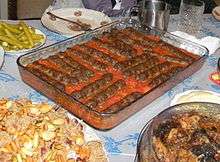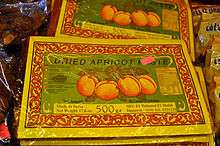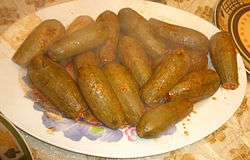Syrian cuisine
%2C_a_traditional_Ancient_Roman_recipe_for_a_classic_fine_bread%2C_from_Athenaeus'_Deipnosophistae_(16336232886).jpg)

Syrian cuisine is a diffusion of the cultures of civilizations that settled in Syria, particularly during and after the Islamic era beginning with the Arab Umayyad conquest, then the eventual Persian-influenced Abbasids and ending with the strong influences of Turkish cuisine, resulting from the coming of the Ottoman Turks. It is in many ways similar to other (Greater Syria) Levantine cuisines, mainly Lebanese, Palestinian, Jordanian and Iraqi.
Syrian cuisine includes dishes like kibbeh, kebab halabi, waraq `inab, hummus, tabbouleh, fattoush, labneh, shawarma, mujaddara, shanklish, bastirma, sujuk and baklava. Syrians often serve selections of appetizers, known as "meze", before the main course, and za`atar, minced beef, and cheese manaqish as hors d'oeuvres. Arabic flat bread is always eaten together with meze. Syrians also make cookies/biscuits called "ka`ak", to usually accompany their cheese. These are made of farina and other ingredients, rolled out, shaped into rings and baked. Another form of a similar cookie is filled with crushed dates mixed with butter to eat with jibbneh mashallale, a string cheese made of curd cheese pulled and twisted together. A spice mixture called "baharat mushakalah" is endemic to Syrian cuisine.
Foods
Muhammara, is a hot pepper dip originally from Aleppo, Syria,[1] found in Levantine and Turkish cuisines. In western Turkey, muhammara is referred to as acuka.
Aleppo pepper, Also known as the Halaby pepper,[2] it starts as pods, which ripen to a burgundy color, and then are semi-dried, de-seeded, then crushed or coarsely ground.[3] The pepper flakes are known in Turkey as pul biber. The pepper is named after Aleppo, a long-inhabited city along the Silk Road in northern Syria, and is grown in Syria and Turkey.
Fattoush, is a Levantine bread salad made from toasted or fried pieces of pita bread (khubz 'arabi) combined with mixed greens and other vegetables, such as radishes and tomatoes.[4] Fattoush belongs to the family of dishes known as fattat (plural) or fatta, which use stale flatbread as a base.[4][5]
Shanklish is typically formed into balls of approximately 6 cm diameter, which are often covered in za'atar and Aleppo pepper, and then aged and dried. The most common spice is thyme, thus giving the cheese its appearance somewhat resembling a dirty tennis ball. Shanklish is also sold in much smaller balls or unformed.
Vine leaves
There are two types of stuffed vine leaves in Syria:
| Name | Description |
|---|---|
| Yabraq (يبرق) | Vine leaves stuffed with rice and minced meat cooked and served hot. |
| Yalanji (يلنجي) | Vine leaves stuffed with rice and a variety of vegetables and served hot or cold. |
Fattah
Fattah is prepared in a wide variety of ways, including:
| Name | Description |
|---|---|
| Fattah bi-as-samna (فتّة بالسمن) | Fattah with hot grease. |
| Fattah bi-az-zayt (فتّة بالزيت) | Fattah with oil. |
| Fattah makdus (فتّة مكدوس) | Fattah with eggplant, minced meat and tomato sauce. |
| Fattah djaj (فتّة دجاج) | Fattah with chicken. |
| Fattah bi-al-lahm (فتّة باللحم) | Fattah with meat. |
Kebab Halabi

Kebab Halabi (كباب حلبي / kibāb Ḥalabī) is a kind of kebab served with a spicy tomato sauce and Aleppo pepper, very common in Syria and Lebanon, named after the city of Aleppo (Ḥalab). Kebab Halabi has around 26 variants,[6] including:
| Name | Description |
|---|---|
| Kebab hindi (كباب هندي) | Rolled lamb with tomato paste, onion, capsicum and pomegranate molasses. |
| Kebab kamayeh (كباب كميه) | Soft meat with truffle pieces, onion and various nuts. |
| Kebab karaz (كباب كرز) | Meatballs (lamb) along with cherries and cherry paste, pine nuts, sugar and pomegranate molasses; it is considered one of Aleppo's main dishes especially among Armenians. |
| Kebab khashkash (كباب خشخاش) | Rolled lamb or beef with chili pepper paste, parsley, garlic and pine nuts. |
| Siniyah kebab (صينية كباب) | Lean minced lamb in a tray added with chili pepper, onion and tomato. |
Kibbeh
A variety of Syrian dishes made with bulgur and minced lamb are called "kibbeh" (كِبّة / kubbah). Aleppo is famous for having more than 17 different types of kibbeh.[7] These include kibbeh prepared with sumac (كِبّة سمّاقية / kubbah summāqīyah), yogurt (كِبّة لبنية / kubbah labanīyah), quince (كِبّة سفرجلية / kubbah safarjalīyah), lemon juice (كِبّة حامض / kubbah ḥāmḍa), pomegranate sauce, cherry sauce, and other varieties, such as the "disk" kibbeh (kubbah qrāṣ), the "plate" kibbeh (كِبّة بالصينية / kubbah bi-aṣ-ṣīnīyah) and the raw kibbeh (كبة نية / kubbah nayyah).
However, kibbeh Halab is an Iraqi version of kibbeh made with a rice crust and named after Aleppo.
Mahshi
Mahshi (محشي / maḥshī) is a famous dish served in Syria. It is essentially zucchini (كوسا / kūsā) or eggplant (باذنجان / bādhinjān) stuffed with ground beef or lamb, nuts and rice.
| Name | Description |
|---|---|
| Badhinjan Mahshi (الباذنجان محشي) | Aubergines stuffed with minced meat, nuts and rice. |
| Kousa Mahshi (كوسا محشي) | Courgettes stuffed with minced meat, nuts and rice. |
Street food

Syrian street food includes:
| Name | Description |
|---|---|
| Falafel (فلافل) | Are fried balls or patties of spiced, mashed chickpeas. Falafel is most often served in Syrian flat bread, with pickles, tahina, hummus, sumac, cut vegetable salad and often, Shatta, a hot sauce, the type used depending on the origin of the falafel maker. |
| Ka'ak (كعك) | Rings of bread commonly sprinkled with sesame seeds or other various seasonings. They can also be filled with dates or walnuts, eaten as a dessert. It is commonly thought to be the Middle Eastern counterpart of the North American bagel. |
| Shawarma (شاورما) | Is usually made with lamb or chicken meat. The meat is sliced and marinated and then roasted on a huge rotating skewer. The cooked meat is shaved off and stuffed into Syrian flat bread and sometimes in French baguettes, plainly with hummus and tahina, or with additional trimmings such as fresh onion, French fries, salads and pickles. |
Sweets

Sweets include:
| Name | Description |
|---|---|
| Asabe'e antakiyyeh (Antioch fingers) | A finger-like rolled and stuffed pastry. |
| Baklava (بقلاوة) | Which Syrians call "baqlawah" (بقلاوة): layered pastry filled with nuts, steeped in a syrup called "qatr" (قطر), and which Syrians usually cut in a triangular or diamond shape. |
| Basbousa (بسبوسة) | A sweet cake made of cooked semolina or farina soaked in simple syrup. |
| Ghazal al-banat (غزل البنات) | Sugar, toasted with a special system and stuffed with pistachios or cashew. |
| Halawa Homsiyeh also called "halawat al-jubn" (حلاوة الجبن) | Pastry rolled and stuffed with cheese or thick milk cream, served with qatr. |
| Halva (حلوة) | A sesame paste sweet, usually made in a slab and studded with fruit and candy/sweets. |
| Kanafeh (كنافه) | Shoelace pastry dessert stuffed with sweet white cheese, nuts and syrup. |
| Ma'amoul (مأمول) | Date, pistachio or walnut filled cookies/biscuits shaped in a wooden mould called a tabu made specially for Christian holidays (traditionally Easter), Muslim holidays (such as Ramadan), and Jewish holidays (Purim). |
| Mamuniyah (مامونية) | Semolina, boiled in water and with significant amounts of sugar and ghee butter added, usually served with salty cheese or milk cream (قشطة / qishṭah). |
| Nabulsiyah (نابلسية) | A layer of semi-salty Nabulsi cheese covered with a semolina dough and drizzled with a honey syrup (qatr). |
| Qada'ef (قطايف) | Semolina dough stuffed with a paste of sweet walnuts or milk cream and honey syrup (qatr). |
| Qamar ad-din (قمر الدين) | Dried apricot paste. |
| Swar as-sitt (سوار الست) | Which means "lady's wristlet". A round pastry steeped in qatr while the centre is covered with smashed pistachios. |
| Taj al-malik (تاج الملك) | Which means "king's crown": round dry pastry, the centre of which is filled with pistachios, cashews or other nuts. |
| Zilabiyah (زلابية) | Thin sheets of semolina dough, boiled, rolled and stuffed with pistachios or milk cream (qishtah). |
| Znud as-sitt (زنود الست) | Which means "lady's arms": filo pastry cigars with various fillings. |
Beverages
| Name | Description |
|---|---|
| Arabic coffee (قهوة عربية) | A beverage made from lightly roasted coffee beans along with cardamom, and served with dates, dried fruit and nuts. |
| Arak (عرق) | A distilled alcoholic spirit, transparent in color, made from anise seeds. |
| Ayran (عيران) | A yogurt-based beverage mixed with salt and water. |
| Jallab (جلاب) | A fruit syrup which can be combined with liquid to form a hot or warm beverage. |
| Mate (المته) | A caffeine-infused drink produced from ground yerba mate leaves and served hot. |
| Polo (بولو) | Mint lemonade. |
| Syrian beer (البيرة السورية) (Al-Shark and Barada beers) | A beverage prepared from yeast-fermented malt, flavored with hops. |
| White coffee (قهوة بيضاء) | Syrian white coffee "ahweh bayda" is a caffeine-free drink made from water, orange blossom water, and sweetened with sugar if desired. Although not the most common substitute for coffee it is occasionally served in lieu of coffee (Turkish coffee). Ahweh bayda is traditionally thought to have a soothing effect when taken. |
| Wine (خمر) | An alcoholic beverage made from fermented grapes. |
See also
- Arab cuisine
- Assyrian cuisine
- Iraqi cuisine
- Jordanian cuisine
- Lebanese cuisine
- Levantine cuisine
- Mediterranean cuisine
- Middle Eastern cuisine
- Ottoman cuisine
- Palestinian cuisine
References
- ↑ The Culinary Institute of America (2008). Garde Manger: The Art and Craft of the Cold Kitchen (Hardcover ed.). Wiley. p. 53. ISBN 0-470-05590-1.
- ↑ "Spices or Herbs or Seasoning Terms". Ockerman's International Food Information. Ohio State University Extension. Retrieved 2010-10-20.
- ↑ David Floyd (June 10, 2010). "The Aleppo Pepper". United Kingdom: The ChileFoundry. Retrieved 2010-10-20.
- 1 2 Wright, 2003, p. 241
- ↑ Claudia Roden, The New Book of Middle Eastern Food, 2008, p. 74
- ↑ "كونا :: المطبخ الحلبي ينفرد بتنوع اطعمته وطيب نكته 11/01/2006". kuna.net.kw.
- ↑ "NPR web: Food Lovers Discover The Joys Of Aleppo".
Further reading
- Gerbino, Virginia Jerro; Kayal, Philip (2002). A taste of Syria. New York: Hippocrene. ISBN 9780781809467.
- Kadé-Badra, Dalal; Badra, Elie (2013). Flavours of Aleppo : celebrating Syrian cuisine. Vancouver, Canada: Whitecap Books. ISBN 9781770501782.
External links
![]() Media related to Cuisine of Syria at Wikimedia Commons
Media related to Cuisine of Syria at Wikimedia Commons







